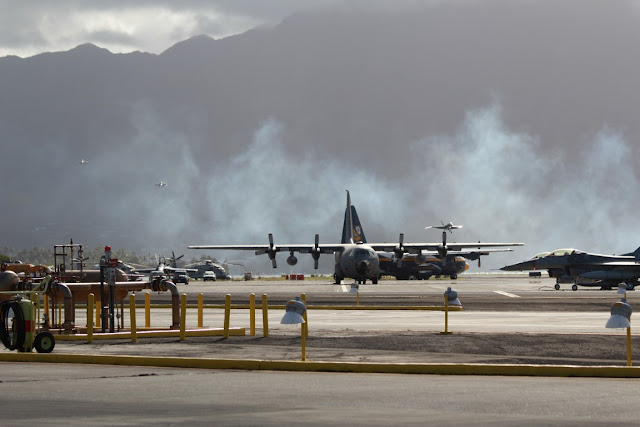Here are the Blue Angels Flying at the Kaneohe Bay Airshow!
For Some musical accompaniment I suggest opening this in the background.
For Some musical accompaniment I suggest opening this in the background.
Here is the line up before they take flight. The pilot in plane 2, John Hiltz, is from Ft. Mitchell, Kentucky!
Here's Faaaaaaaatttt Alllllllllbert!
Fat Albert carries all the equipment that the blue angels use as the travel the country doing shows.
Four of six blue angels take off in a close diamond pattern all at once.
The fifth takes off at a very sharp angle right away.
The Sixth starts a barrow roll as soon and he gets off the ground.
These pilots will fly with only 18 inches between them during the Diamond 360 maneuver.
Other times they will fligh directly at each other, turning sideways right before the would collide.
I don't have much to say with these pictures so I just give you a few Blue Angels facts.
The Chief of Naval Operations, Admiral Chester W. Nimitz, ordered the establishment of the team on April 24, 1946.
The name, "Blue Angels", was picked by the original team when they were planning a show in New York in 1946. One of them came across the name of the city's famous Blue Angel nightclub in the New Yorker Magazine.
The mission of the Blue Angels is to enhance Navy recruiting, and credibly represent Navy and Marine Corps aviation to the United States and its Armed Forces to America and other countries as international ambassadors of good will.
Each Blue Angel demonstration pilot must be career-oriented, carrier-qualified, active-duty Navy or Marine Corps tactical jet pilot with a minimum of 1,250 flight hours.
All of the Blue Angels' jets are carrier-capable and can be made combat ready in about 72 hours. The demonstration pilots fly the jets to each show site.
The lowest and highest maneuver heights performed during an air show varies due to weather conditions. The highest is the vertical rolls performed by the Opposing Solo (up to 15,000 feet) and the lowest is the Sneak Pass (50 feet) performed by the Lead Solo.
The fastest speed flown during an air show is about 700 mph (just under Mach 1; Sneak Pass) and the slowest speed is about 120 mph (indicated speed; Section High Alpha), both flown by the solo pilots during the show.
The blue angles signature star bust maneuver
The air condensing over the wings is cool.
I like seeing the flames out of the jet engines.
They don't land as close together as they took off but it is one right after another. Three are in this picture all coming in for a landing.






























No comments:
Post a Comment